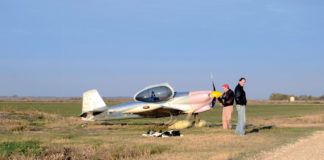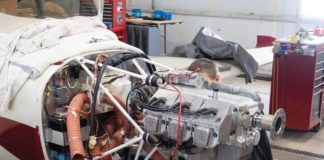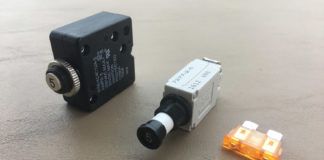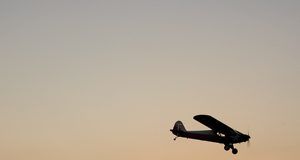When you tackle any kit or plansbuilt airplane, you’ll inevitably come upon snags. “How do I hook this onto that? It just don’t fit right!” Then it’s back to the drawings or notebooks, and before you know it you’ll figure out the answer. If you’re stuck, you can always seek out someone who’s built an airplane like yours and ask how it’s done, or you can go look at another completed airplane to see how all the little mysteries have been solved.
Restoring a damaged or neglected older airplane is a different story altogether. In most cases, no plans exist for it, especially when you plan to convert it to some sort of Experimental. But if you’re really stuck on some point of assembly, you can generally find another sample of the airplane somewhere, even though it might be in Timbuktu. You may be able to obtain photos and assembly notes from another owner, and thus you can get the inside story on whatever it is you’re trying to accomplish.
How I wish I could do that! But in my case, it’s impossible. I’m restoring a damaged airplane that is the prototype of what was to become a series of airplanes that never materialized, so today there is only one of these in the whole world: my airplane, the Dalotel DM165.
Continental IO-346A, built new by Rolls Royce for this airplane. Yep, that’s the same engine used by the Beech Musketeer—essentially two-thirds of an IO 520. The fuel-injected engine spun a Regy 2025 fixed-pitch wood prop; the oil feed is modified for endless inverted fl ying. The Dalotel was in contention with the CAP for use as a trainer by the French Air Force, and the CAP won out. This didn’t sit well with the designer, Michel Dalotel.
The good news is that plans for my airplane do exist. The bad news is that Dalotel, who speaks only French and is now 75, refuses to help with the restoration. I’m sure he has good reasons for his steadfast refusal, but I can’t imagine what they are. He still clings to the dream of seeing his aircraft in production, and he even asked me to pursue that goal for him. But for nearly a quarter of the entire history of aviation, his lone aircraft has been in storage, not in the air where it belongs. None of the people I’ve talked with in aviation know of the Dalotel, so the first logical step would be to get the airplane fl ying.
I bought the plane from its previous owner, Robert “Robs” Lamplough, a noted British collector and pilot of numerous WW-II aircraft including Mustangs and Spitfires for the movie industry. He bought the DM165 in 1981. He told me that when he picked up the airplane in France and prepared to fly it to England, he received no walk-around, no instructions, no explanatory flight. Basically Dalotel said, “Here’s your airplane. Goodbye.”
Lamplough drew upon his vast experience with many types of aircraft and successfully flew the Dalotel home to England. During the next few years he flew it a total of about 15 hours before
When you tackle any kit or plansbuilt airplane, you’ll inevitably come upon snags. “How do I hook this onto that? It just don’t fit right!” Then it’s back to the drawings or notebooks, and before you know it you’ll figure out the answer. If you’re stuck, you can always seek out someone who’s built an airplane like yours and ask how it’s done, or you can go look at another completed airplane to see how all the little mysteries have been solved.
Restoring a damaged or neglected older airplane is a different story altogether. In most cases, no plans exist for it, especially when you plan to convert it to some sort of Experimental. But if you’re really stuck on some point of assembly, you can generally find another sample of the airplane somewhere, even though it might be in Timbuktu. You may be able to obtain photos and assembly notes from another owner, and thus you can get the inside story on whatever it is you’re trying to accomplish.
How I wish I could do that! But in my case, it’s impossible. I’m restoring a damaged airplane that is the prototype of what was to become a series of airplanes that never materialized, so today there is only one of these in the whole world: my airplane, the Dalotel DM165.
History Lesson
Th e DM165 first flew in 1969. It features a tube-and-rag fuselage and wood-covered wings, with conventional and retractable gear. It is fully aerobatic, seats two in tandem, and is flown from the back seat. The dry weight is about 1380 pounds; gross is 1850. Power is a 165-horsepower disaster struck. Largely because of his lack of detailed information, he suffered a power outage and had a forced landing, putting the Dalotel down in a cornfield. This damaged the plane badly enough that Lamplough declined to have it rebuilt. He put it into storage, where it languished for nearly a quarter century.
Luck was with me, or perhaps fate. I had just begun an Internet search for a good set of drawings or photos of the Dalotel so I could build a radio-controlled model of it. The Dalotel is popular with the RC crowd. I had built a model of it myself 20 years ago, and I wanted to do it again, better, complete with retracts. When I found the real thing for sale, I quickly decided to rebuild the original. I needed a big project, and this would be it. I made the necessary arrangements, largely through emails, and the airplane arrived in Idaho in September 2006.
Reality Sets In
What we unloaded was a dingy, broken wreck. The remaining yellow and white fabric was torn and moldy. Large chunks of the wingroots had been ripped out, but were included in the package. The propeller, spinner and canopy had been smashed in the forced landing when the airplane turned over. I brought the fuselage into my front room (one of the advantages of bachelorhood) so I could work on it during the cold winter months. The first thing I did was strip off the old fabric and wipe the tubing down with disinfectant. Then began a slow, yet eye-opening disassembly and documentation process. I have taken more than 1000 photographs of every step and detail along the way. These have already proven to be valuable, even though I haven’t made great strides in rebuilding. One of the biggest problems has been comprehending what is right in front of me. I still don’t fully understand what I have.
A Puzzlement
The landing gear is a prime example. I removed one gear leg from the wing along with the worm-gear mechanism that drives it, but not all of the original structure was present. I didn’t realize for months how it operated. I was sure the powerful little motor that moves the gear up and down had to be reversed to give both directions of motion to the gear legs. But the way the motor was wired, it could not be reversed.
Other electronics are associated with the retracts, including two small circuit boards holding resistors, capacitors and diodes. There is a “magic” box, installed so that its label was obscured. And there is the gear relay, contained within a transparent plastic cover. Surely some electronic wizardry would result in the motor spinning in the opposite direction?
With the motor out of the airplane and cleaned up, I discovered I could make it run in reverse by crossing two sets of wires on its four poles. I drew a wiring diagram for it. My hope was to eliminate some of the miles of wiring in the plane. I could understand the use of a relay for the gear motor. You send a small current to the relay, which in turn directs the high-amperage current to the motor, much like a starter relay. But the function of the capacitors, resistors and diodes remained a mystery.
Then, by luck, two things happened. First, I saw a vague reference on the Internet to electronic braking for DC motors; second, I ran the gear motor once again, and as I cut the power I noticed that the worm-gear-driven axle, the thing that spins the gear legs up and down, continued to rotate for a good turn and a half with no power going to the motor. Slowly the light went on. If that axle had continued spinning after the microswitch for the full-up position had cut the power, the gear leg would continue rising and maybe bust something. It was necessary to brake the motor to a complete stop the instant the microswitch cuts the power. Back to the Internet. There I found a simple circuit that is designed to stop a DC motor in its tracks once the power is cut. This circuit looked exactly like what I had behind the instrument panel. One mystery solved. Another small circuit board performs the same braking function for the elevator-trim motor. But the question of reversing the gear motor remained, and nagged.
When the airplane arrived, several bags and boxes of parts and broken bits came with it. These had all been carefully picked up from the plowed field where the plane went down. After diligent inspection I could tell where most of the chunks came from, but there was one part I couldn’t identify. It was angular, made of heavy steel, and had several holes for lightness. Each end held a bearing, and there was a tapered pin wedged into one of them. The size and strength of this part made me think it was something off the landing gear, but it didn’t seem to fit anywhere, and there was only one.
Months later, I took another look at my disassembly pictures and realized the spar-mounted worm gear that moved the gear leg was not directly connected to the gear leg itself. Its center of rotation was about 6 inches away from the gear-leg hub. Therefore, there must have been some link between the two, which would translate the rotation of the gearbox to the up-and-down movement of the gear leg. In fact, that is exactly what the previously unidentified part does. It links the worm-gear-driven rotary arm in the spar to the gear leg in a sort of parallelogram system. As the link is driven around the clock in only one direction, it first picks up the leg and pulls it into storage within the wing, and then drives the leg downward to the fully extended position. Microswitches control the up and down, and the electric brake stops the leg when the power cuts. Long story short, the gear motor never changes direction.
A placard (in English) placed next to the emergency gear-extension crank provided a clue. It read that the crank must be turned only clockwise and never reversed, or else the microswitches on the gear legs would be damaged. Stands to reason that if the DC motor turned in a reverse direction then it, too, would damage the microswitches. If the gear motor fails with the gear halfway up, the operator must crank the gear up and then down again, turning the crank only clockwise.
To verify this setup and illustrate its operation to the DAR and curious friends, I made a wood mockup with all the center distances full size. Because the dimensions are exact, the mockup shows the precise movements of the actual system. Making the mockup and verifying the operation took an enormous load off my mind. Now I know it’ll be easy to adjust the microswitches once it’s all rebuilt. But one quick look at the plans would have saved me months of frustration.
Restoration: Change or Duplicate?
One of the first things I did, even before the airplane arrived, was to get an OK from the FAA to rebuild the Dalotel as an Amateur-Built aircraft, and an historic exhibition airplane. Thus it can retain its original French F-PPZE markings, a major part of its history. A full restoration could return the airplane to its original condition, but what to do when one fi nds something done entirely wrong? For example, the Dalotel’s cowling was attached directly to the engine. It was split vertically, and there was no oil-inspection door. If you’ve read Tony Bingelis, you know that’s all wrong. Th e fiberglass cowling has numerous cracks despite its low total time, and the designer acknowledged the cowling setup had problems.
My intent is to make it a better airplane, even though it might look slightly different. I’ll split the new cowling horizontally, hang it off the fuselage, and give it an oil door. I’ll need to install lights, though the original had none. The instrument panel is mighty small. The original setup had some critical gauges in the front panel, so the driver had to look past the passenger to read them. With today’s smaller instruments it makes sense to put everything into the rear panel. The original instruments were metric, and I may leave some of them in the front panel for the sake of history. I redesigned the main panel to be easier to read. Fuses will become circuit breakers.
I know I’ll have to build a new pair of wings. They plug into the fuselage in a sturdy and clever system, the likes of which I’ve never seen. The right and left mainspars are joined by two large aluminum plates within the fuselage, which are the backbone of the entire design. In the forced landing the right wing suffered the most damage, and has a cracked spar. The previous owner had a restoration survey done, and it seems the left spar is still good. Some new ribs are in order. They are plywood, with spruce cap strips. There are 14 per wing, but only two are of a given size (one in each wing) because of the wing taper. The wings are covered entirely with wood except for the ailerons, which are covered in fabric. The aileron links are torque tubes, said to give wonderfully precise controls.
The Dalotel has no flaps. It originally had dive brakes, which popped up directly in front of the ailerons, and didn’t make sense. I found out the air brakes had been disabled by the designer. In one of his few emails, he told me the air brakes caused (surprise!) major problems with the ailerons. The proposed, but never built, future Dalotels were to have flaps on the three variants of the airplane, two of them with fixed gear. The Dalotel was designed to be a trainer, much like a Cessna 150 or 172, but with aerobatic capabilities, and the design is largely modular, with an eye to easy repair. Hence, the plug-in wings and other quick-change innovations.
The French equivalent of our FAA tested the airplane thoroughly toward type certification, and verified the performance specifications. Stall speed is 56 mph, not bad for an airplane with a top speed of nearly 190 mph and a cruise of 150 at 60% power. A clean design can pay remarkable dividends.
Is it all worth it? The fuselage and engine have a total time of just more than 300 hours, so even though this airplane is 40 years old, much of it is essentially new. It has some wonderful design aspects, the result of a genius at the drawing board. The Dalotel DM165 was realized through brilliant, even masterful machine work from the French company Poulet, Father & Sons. The restoration won’t be easy, but other than the wiring, it looks like straightforward and relatively simple construction. Word from the few folks who flew it or rode in it is that it was one of the best-flying aircraft in existence. That’s enough for me.





